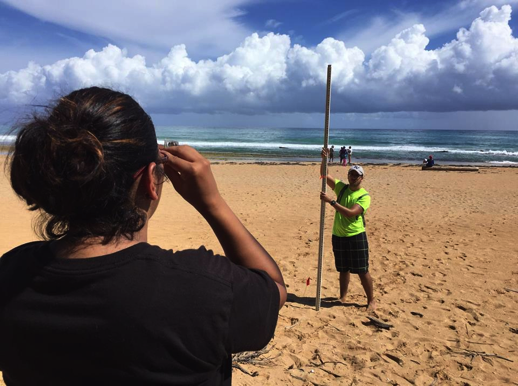This week the San Juan Bay Estuary Program said goodbye to our former Executive Director for the past eleven (11) years, Dr. Javier Laureano. He will be working as the Director of Clean Water Division at the EPA’s Region 2 Division, located in New York City. We congratulate Dr. Laureano and wish him great success. In turn, we welcome our new Executive Director, Brenda Torres, MEM & LEED AP. Brenda served as a Board member of the SJBEP for 11 years. Her leadership and commitment to the Program will help us continue to achieve greater social and environmental justice for our estuary communities.
9.6.2016. Water Quality Monitoring Program with Volunteers
This week six (6) volunteers supported our Water Quality Monitoring Coordinator, Harold Manrique, in sampling water from six (6) monitoring stations at the San Juan Bay.
09.01.2016. Inventory of current and past adaptations to climate change in the Martín Peña Channel Communities
This week we continued developing activities for the Inventory of Current and Past Adaptations to Climate Change Project. Our Climate Change Community Coordinator, geographer Roberto Morales, conducted a workshop in Santiago Iglesias Pantín School in the community of Barrio Obrero using urban music and creative composition. The workshop was provided by four urban local artists: Vladi, Robertito Chong, and Yambo y Keila, and facilitated by Fabiola Robles and Omar Pérez. This project is sponsored by the New York Community Trust, and will help us explore climate change community adaptation strategies and create a vulnerability and risk geodatabase.
9.9.2016, Coastal Profile in Piñones Beach:
Continuing our Citizen Science and Dune Restoration initiatives, our Habitat Restoration Specialist, biologist Ivangs Rivera, MSc, guided eight (8) volunteers to monitor and draw a profile of the coastline of Piñones. These results help us track down and scientifically document dune migration in the zone.

9.10.2016. Rain garden at the Condado Lagoon
On Saturday, September 10th, we held a remarkable activity at the Estuarine Natural Reserve of the Condado Lagoon: The creation of a rain garden that collects rainwater, allows it to soak into the ground and filters it to the water bodies in a cleaner way. MillerCoors sponsored this initiative, with thirty (30) corporate volunteers. We gave them the opportunity of restoring eroded areas of the lagoon by planting 40 red mangrove trees; testing the quality of the waters, and classifying microplastics found in the sand. The event was well documented and widely covered in radio, TV and social media. This important initiative was part of our ongoing efforts to provide citizen science opportunities to our denizens. Gladys Rivera, our Outreach Manager, led the events of the day with the support of AmeriCorps VISTA volunteers and other staff members of the San Juan Bay Estuary Program.
Video:
9.10.2016. Underwater trash cleanup at the Estuarine Natural Reserve of the Condado Lagoon:
Our Habitat Restoration Specialist, biologist Ivangs Rivera, led an underwater trash removal at the Condado Lagoon with the support from the University of Puerto Rico’s Capitulo Estudiantil de la Sociedad Ambiente Marino (CESAM), and the collaboration of La Federación de Remo de Puerto Rico. Dozens of volunteers were divided in two groups: the divers grabbed trash from the bottom of the lagoon, and others picked up trash from the surroundings. A total of twelve (12) trash bags, two hundred (200) glass bottles, tires and other plastics were collected underwater and on the sand.
Link to the news: